For the past six decades, one dynastic family has single-handedly portrayed itself as the greatest martyrs and heroes of the country, while most leaders either died in ignominy or were consigned to the dustbins of history
-DR Sudhir Bisht
It is seldom that a Prime Minister gives back as good as he gets. That is the trait of irrepressible Dr Subramanian Swamy. While Dr Swamy never fights shy of a direct duel, something which he mostly wins, Prime Minister Narendra Modi gives it back in a humorous and sarcastic manner. To those who tried to ruffle him with the abominable ‘Chowkidar chor hai’ slogan, he always answered in a very restrained manner. But last week Prime Minister shed his cool and went in for the jugular – the former Prime Minister Rajiv Gandhi, as someone who would be remembered as one of the most corrupt people of all times.
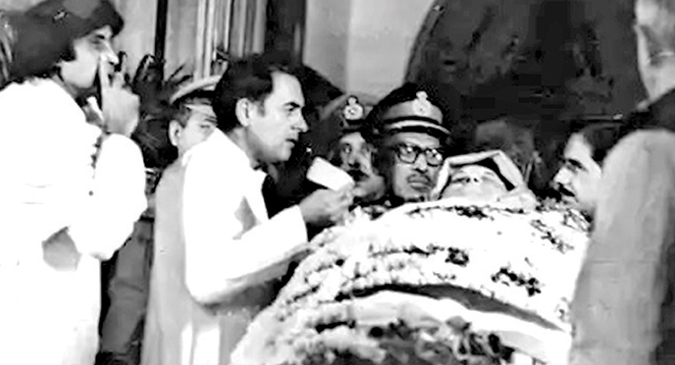
Rajiv Gandhi and actor Amitabh Bachchan beside the body of former Prime Minister Indira Gandhi
Modi’s attack on Rajiv Gandhi was indeed a reaction to the vilification campaign that was unleashed upon him by the ‘united-for-power’ coalition of incongruent political parties. He had been called various unprintable names but when Rahul Gandhi tried to up his pitch on the imaginary ‘corruption’ against Modi, the latter hit back with vengeance that is not associated with his style of humourous circumlocution.
have we ever heard the Congress party giving credit to LN Mishra or Beant Singh as ‘martyrs’? I haven’t mentioned the name of Syama Prasad Mookerjee, the founding father of Jan Sangh, who died in isolation in a neglected guest house in Jammu-&-Kashmir, lest the readers think that I am trying to divide the scope of martyrdom between the left and the right!
The Nehru-Gandhi family and their followers were all over the press in trying to attack Modi again. They made several undignified attacks on the PM and his family and there isn’t much need to dwell upon these remarks. Here I want to talk about the claims of sacrifices that are said to be have been made by the Nehru family.
Rajiv Gandhi, Sonia Gandhi as martyrs?
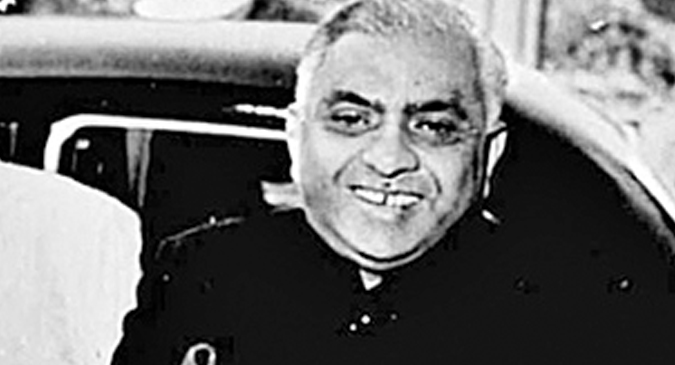
Former Congress Leader LN Mishra
I seek the indulgence of my readers to examine the ‘sacrifices’ made by Nehru-Gandhi family. As per Priyanka Gandhi Vadra, her father Rajiv Gandhi and grand-mother, Indira Gandhi, achieved martyrdom for the sake of the country. Let us examine if there was any sense of martyrdom involved in unfortunate killings of Indira Gandhi and Rajiv Gandhi. It also needs to be checked if indeed meeting one’s end at the hands of an assassin is the same as achieving martyrdom. And indeed it is necessary to define the term martyrdom itself. We would also find out if the services rendered by the Nehru-Gandhi family indeed were not reciprocated in equal measure by our motherland.
Pandit ji enjoyed regular periods of parole interspersed with not so unpleasant stay in jail. He could meet people he wanted to see and his supplies of books and other consumables were always in abundance, available to him at all times. Nehru never experienced the hard labour, from dawn-to-dusk, that Veer Savarkar facedI am one of the staunchest critics of the Nehru-Gandhi family but I cried inconsolably when Ms Gandhi was assassinated by her own bodyguards. My family and I mourned when Rajiv Gandhi was killed by in a suicide bomb attack in Sriperumbudur by a highly motivated terrorist of Liberation Tigers of Tamil Eelam (LTTE). I say this to make it abundantly clear that the killings of Indira Gandhi and Rajiv Gandhi are two of the most unfortunate and heart-rending events of free India. Also unfortunate was the slaughter of Lalit Narayan Mishra in the Samastipur blast. Also unfortunate was the death of Beant Singh, the Chief Minister of Punjab who was killed in a car bombing.
But have we ever heard the Congress party ever giving the credit to LN Mishra or Beant Singh as ‘martyrs’? I haven’t mentioned the name of Syama Prasad Mookerjee, the founding father of Jan Sangh, who died in isolation in a neglected guest house in Jammu-&-Kashmir, lest the readers think that I am trying to divide the scope of martyrdom between the left and the right!
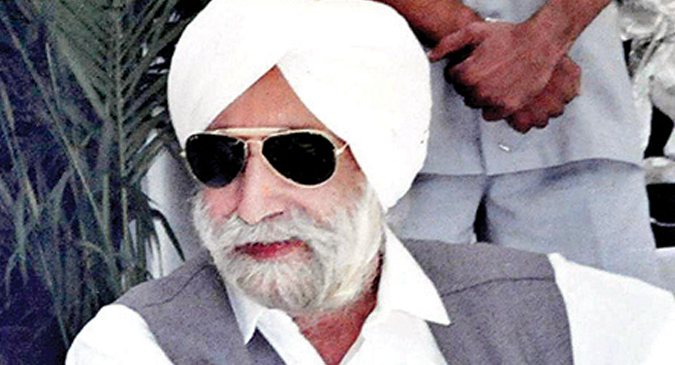
Former CM of Punjab Beant Singh
So who qualifies to be a martyr?
One of the earliest martyrs was Abhimanyu, the young son of Arjun and Subhadra, who died a valiant death in the ‘Chakravyuha’ battle arrangement of the Kaurava army. Abhimanyu is the most valiant of all heroes of the battle of Mahabharat.
Our martyrs died for their sacred cause, for freedom of our country. They didn’t lay down their lives so that their future generations could encash their martyrdom for the power gamesOne of the greatest warriors and teachers of Mahabharat, Dronacharya, was also killed in Mahabharat. But he was beheaded by the brother of Draupadi, Dhrishtadyum (the Panchala prince ) when Dronacharya was unarmed and in a state of grief at the perceived loss of his son’s life. Dronacharya didn’t die a martyr’s death. He didn’t die fighting but he died while he was grieving.
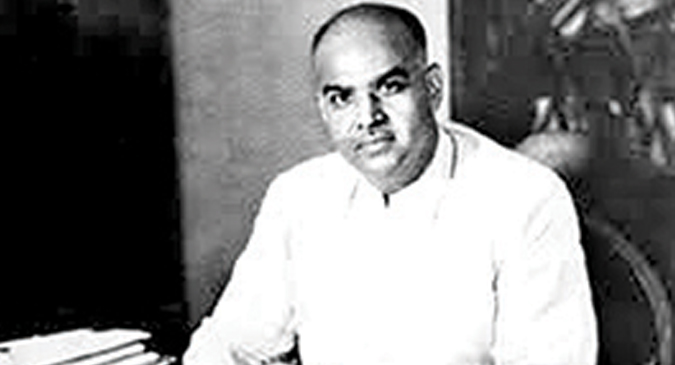
Jan Sangh Founder Syama Prasad Mookerjee
A person achieves martyrdom if he or she is killed or made to suffer greatly because of his/ her political or religious beliefs. In case of a martyr, he/ she is mostly up against the mighty force of the state that is tyrannical, dictatorial, authoritarian and iniquitous.
Indira ji was killed by her bodyguards, the same men who ironically were supposed to guard her against any harm. Even though she was advised to remove the Sikh bodyguards, she insisted on retaining them as she didn’t believe that her most trusted protectors would ever think of killing her. Indira ji fell to a gory death but she wasn’t martyred as she didn’t die in any battle or any war action. It was not as if she knew that she could be killed and yet she ventured to fight and fell in the battle field.
It may be mentioned here that even General A S Vaidya (retd) was assassinated by the banned Khalistani Commando Force (KCF) in 1984 because Vaidya had spearheaded Operation Blue Star in 1984. In June 1991, KCF killed about fifty train passengers, mostly Hindus in the northwestern Punjab. In September 1993, they indulged in a bombing operation in New Delhi targeting Indian Youth Congress president Maninderjeet Singh Bitta. The target of the operation survived but the dastardly act of KCF killed eight people. The point I am making is that Indira Gandhi was killed by the militants and this happens to be one of the most unfortunate events of our time. But then many others too were killed in acts of terrorism. In 1987, these militants killed 35 bus passengers in Haryana, all of them Hindus. Do we call these victims, ‘Shaheeds’? We cry for them but the term we use for them is not martyr but ‘victims’ of terrorism.
Rajiv Gandhi too fell to the evil designs of a very determined, very motivated and a very deadly organization that held much hatred against Rajiv. LTTE held the view that Rajiv Gandhi had tried to finish it off and they wanted to take a revenge on his. The writer of contemporary history will forever be divided on the merits of Rajiv’s direct engagement in the internal, bloody politics of Sri Lanka. Rajiv died a grisly death and his killing was a body blow to India’s morale and its prestige but Rajiv’s end was not something that was an act of laying down one’s life for the country. Many others died in the blast that killed Rajiv and we don’t remember them as martyrs. We remember them as the victims of terrorism.
Assassinations are not uncommon
Indira and Rajiv were killed by mad zealots just as John F. Kennedy was assassinated in 1963 by a crazy man called Oswald. Politics is a risky business and many a ruler in Indian sub-continent have been killed by mad zealots. Zulfikar Ali Bhutto, the top leader of Pakistan was hanged to death in 1979 and his daughter was assassinated in 2007. In Bangladesh, Sheikh Mujibur Rahman and Ziaur Rahman were assassinated. Ranasinghe Premadas, the President of Sri Lanka was assassinated in 1993. Closer home in India, Lalit Narayan Mishra was killed in bomb blast in 1975 at Samastipur Railway station. Lalit Maken was gunned down in 1985 by Harjinder Singh Jinda, Sukhdev Singh Sukha and Ranjit Singh for Maken’s alleged involvement in the 1984 anti-Sikh riots. Jan Sangha’s founder, Dr Syama Prasad Mookerjee died in solitary confinement in his fight against restriction of free movements of non-Kashmiri Indians in J&K.
The point that I am trying to make is that Indira ji and Rajiv Gandhi died under extremely unfortunate circumstances but to call their unfortunate end(s) as acts of martyrdom is needless glorification. Examining the sacrifices made by other Nehru parivaar leaders Since Indian National Congress party leaders always talk about the sacrifices made by Nehru- Gandhi parivaar, let me also examine in detail the lives of the members of this family from Moti Lal Nehru onwards.
Moti Lal Nehru was a lawyer, some even say that he was just a pleader, who was an immensely wealthy man. His son, Jawahar Lal Nehru was a great leader but not the greatest in his initial days. He was easily overshadowed by more illustrious men like Netaji Subhash Chandra Bose and Sardar Patel. However due to the enormous patronage that Nehru ji received from Mahatma Gandhi, he succeeded in becoming the Prime Minister of India.
Pandit ji, as JLN Nehru was lovingly called, was the darling of free India and he enjoyed being the Prime Minister of India for seventeen long years. Nehru did go to jail during the freedom struggle but his several years in jail were by no means years of solitary and stressful imprisonment. Pandit ji enjoyed regular periods of parole interspersed with not so unpleasant stay in jail. He could meet people he wanted to see and his supplies of books and other consumables were always in abundance, available to him at all times. Nehru never experienced the hard labour, from dawn-to-dusk, that Veer Savarkar faced.
Who knows if Nehru was subjected to Savarkar-like labour, he may have cracked up within hours of his arrival at the notorious Cellular jail?
Jawahar Lal Nehru always led a glorious life. Even while he was in prison he was the best friend to the British rulers and this must have weighed all the time on the minds of his jail superintendents. All in all, Jawahar Lal Nehru, a man of limited achievement either as a lawyer or a freedom fighter, lived the life of being the favoured son of Mother India. Nehru ji as India’s Prime Minster led a great life, in his Teen Murti house. I personally believe that Moti Lal ji and his son received far more from India than what they gave to India. From the anonymity of being just another lawyer in Allahabad, Moti Lal was propelled to the post of President of Congress party and his son was crowned the Prime Minister of India bypassing many other more meritorious men of his age.
Indira Gandhi, Pandit ji’s daughter, ruled India with an iron hand for fifteen years. Between Bank nationalization and liberation of Bangladesh, she also imposed a state of Emergency in 1975. Indira Gandhi also enjoyed all the luxuries associated with being the Prime Minister’s daughter and being the Prime Minister herself for all but two years in her life, after India attained independence. She was the uncrowned Monarch of her party and the government and did what she deemed fit, without much ado about the consequences. Her mentality rubbed on to her younger son, Sanjay Gandhi, who ran a massively unpopular sterilization programme without holding any position in the government. There are stories, some of them a bit fancy, of course, that Sanjay Gandhi’s buddies oversaw the razing of illegal settlements in Old Delhi without giving out sufficient notice of eviction.
Rajiv Gandhi too led a charmed life, all thanks to being Indira’s son. He walked out of the cockpit to the chair of India’s Prime Minister without any opposition. No doubt the poor Rajiv became the Prime Minster under tragic circumstances but he too had a great run from 1984 to 1989 as the Prime Minister.
Sonia Gandhi, the present inheritor of Nehru Gandhi dynasty, enjoyed a bull run too from 1989 to 2014 as the unchallenged leader of Congress party. From 2004 to 2014, she ran the UPA Government from the back seat and this period also coincided with the increasing business fortunes of her son-in-law’s real estate empire. Even between 1998 and 2004 when Atal Behari Vajpayee was the Prime Minister of India, Sonia Gandhi didn’t have an uneasy time. Advani ji, the Home Minister, clasped his hand and bowed a little whenever he met Sonia ji in the corridors of power.
The latest middle-aged generation of Nehru Gandhi parivaar, represented by Rahul Gandhi and Priyanka Vadra, continues to enjoy being the ultimate power centres of the oldest political party of India.
I wish the family all the best but my case is that the nation has given the family infinitely more than what they have given to the nation.
The real martyrs of India
To me martyrdom or to be a ‘Shaheed’ is too sacred a word to be used extravagantly.
Chandra Shekhar Azad was just 24 when he died fighting the British-Raj police at Alfred Park in 1931. Bhagat Singh and Sukhdev were just 23 and their fellow revolutionary, Rajguru just 22 when the trio was hanged by the British in 1931.
And lest we forget, Khudiram Bose was just 18 when he was hanged to death in 1908.
India has this tradition of an 18 year old Khudiram Bose who smiled when he was sentenced to death. I read it in India Today some months ago that when Khudiram Bose was asked to say something after the death sentence was pronounced on his, he said that if he was given some more time, he could teach the Judge the skill of bomb-making!
Our martyrs died for their sacred cause, for freedom of our country. They didn’t lay down their lives so that their future generations could encash their martyrdom for the power games.
This is what martyrdom is all about.
(The writer is a freelance columnist)


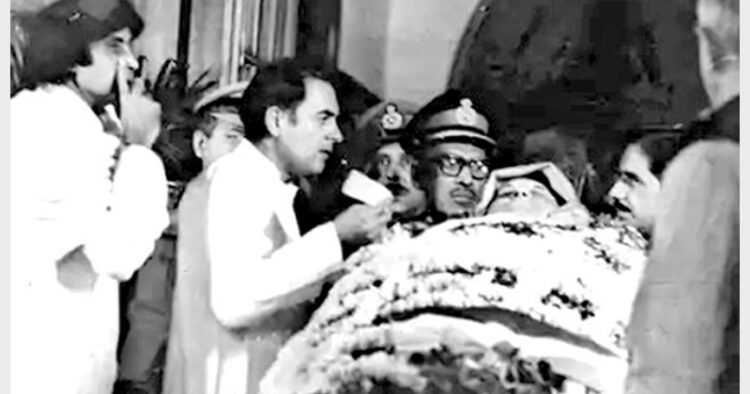










Comments